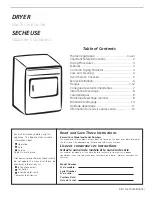
Installation and service must be performed by a qualified installer, service agency or the gas supplier.
IMPORTANT: Have your dryer installed properly.
NOTE: The WARNING and IMPORTANT instructions appearing in this manual are not meant to cover all
possible conditions and situations that may occur. It must be understood that common sense, caution, and
carefulness are factors that CANNOT be built into the dryer. These factors MUST BE supplied by the person(s)
installing, maintaining, or operating the dryer.
Failure to install, maintain, and/or operate this machine according to the manufacturer’s instructions may result
in conditions which can produce bodily injury and/or property damage.
5
This dryer comes ready for top exhausting.
WARNINGS
• DO NOT USE NON METALLIC FLEXIBLE
DUCT.
• Never use flexible duct inside the dryer.
• Do not terminate exhaust in a chimney, range hood,
gas vent, floor or attic. The combination of lint and
grease could create a fire hazard or damages.
• Provide an access for inspection and cleaning the
exhaust system at least once a year. (See Care and
Cleaning Section.)
EXHAUST LENGTH
The MAXIMUM ALLOWABLE length of the exhaust
system depends upon the type of duct, number of
turns, the type of exhaust hood (wall cap), and all
conditions noted below. The maximum allowable
length for both rigid and flexible metal duct is shown
in the table 1 (next page). More than four 90˚ turns is
not recommended.
EXHAUST SYSTEM CHECK LIST
HOOD or WALL CAP
• Terminate in a manner to prevent back drafts or
entry of birds or other wildlife.
• Termination should present minimal resistance to the
exhaust air flow and should require little or no
maintenance to prevent clogging.
• Wall caps must be installed at least 300 mm (12”)
above ground level or any other obstruction with the
opening pointed down.
• If roof vents or louvered plenums are used, they
must be equivalent to a 100 mm (4”) dampered wall
cap in regard to resistance to air flow, prevention of
back drafts and maintenance required to prevent
clogging.
SEPARATION OF TURNS
Separate all turns by at least 1 m (3 ft.) of straight
duct, including distance between last turn and
dampered wall cap. If two turns must be closer than 1
m (3 ft.) deduct 3 m (10 ft.) from the maximum
lengths shown in the table for each occurrence.
TURNS OTHER THAN 90˚
• One turn of 45˚ or less may be ignored.
• Two 45˚ turns should be treated as one 90˚.
• Each turn over 45˚ should be treated as one 90˚.
SEALING OF JOINTS
• All joints should be tight to avoid leaks. The male
end of each section of duct must point away from
the dryer.
• Do not assemble the duct work with fasteners that
extend into the duct. They will serve as a collection
point for lint.
• Duct joints can be made air and moisture-tight by
wrapping the overlapped joints with duct tape.
INSULATION
• Duct work which runs through an unheated area or is
near an air conditioning duct, should be insulated to
reduce condensation and lint build up and be sloped
down toward outdoors.
NOTE:
Never install screen inside exhaust duct.
WARNING: THE DRYER MUST EXHAUST TO
THE OUTDOORS.
TO PREVENT LARGE AMOUNTS OF LINT AND
MOISTURE FROM ACCUMULATING AND TO
MAINTAIN DRYING EFFICIENCY, THIS
MACHINE MUST BE EXHAUSTED OUTDOORS.
INSTALLATION INSTRUCTIONS
EXHAUST
Installation Instructions Exhaust
Summary of Contents for PCKS443EBWW
Page 15: ...15 NOTES ...
Page 31: ...15 NOTES ...






































